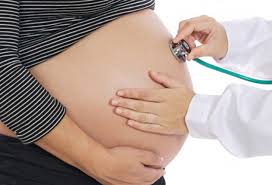Pregnant with osteogenesis imperfect type IV, one case.
Keywords:
DeCS, Imperfect Osteogenesis, Genetics, Pregnant WomenAbstract
Introduction. The imperfect osteogenesis or Bones of Glass genetic illness, of transmission dominant autosomal; in specific the type IV, the patients are born with fractures and bends of the long bones of the inferior members, they show imperfect dentinogenesis, gray or white sclerotics and there is not deafness and it usually presents kyphoscoliosis and laxity ligaments.
Presentation of case. Case of pregnant 24 years of age, white, is reported the symptoms mainly they are observed in muscle-skeletal system, vision, neurological. Primitive elective Caesarean operation, baby healthy, good apgar punctuation, not maternal complications neither neonatal, trans-operative and surgical puerperium: immediate, mediate and late without complications.
Conclusions. The purpose of writing article, to report case of a pregnant one with illness of genetic wide heterogeneity that determines variability phenotype that allows to face a prenatal good attention starting from showing the clinical manifestations of OI type IV observed in the pregnant one.
Downloads
References
1. Sterian A, Balanescu R, Barbilian A, Ulici A. Osteosynthesis in osteogenesis imperfecta, telescopic versus non-telescopic nailing. J Med Life [Internet]. 2015 Oct-Dec [cited 2016 Jan 18]; 8(4): 563-5.
Available from: http://www.ncbi.nlm.nih.gov/pubmed/26664490
2. Liu HY, Huang J, Wu D, Li T, Guo LJ, Guo QN, Wang HD, Wang RL, Wang Y. Collagen type I alpha 1 mutation causes Osteogenesis Imperfecta from mild to perinatal death in a chinese family. Chin Med J (Engl) [Internet]. 2016 Jan 5th [cited 2016 Jan 18]; 129(1): 88-91. doi: 10.4103/0366-6999.172600.
Available from: http://www.ncbi.nlm.nih.gov/pubmed/26712438
3. Palomo T, Andrade MC, Peters BS, Reis FA, Carvalhaes JT, Glorieux FH, Rauch F, Lazaretti-Castro M. Evaluation of a modified pamidronate protocol for the treatment of Osteogenesis Imperfecta. Calcif Tissue Int [Internet]. 2016 Jan [cited 2016 Jan 18]; 98(1): 42-8. doi:10.1007/s00223-015-0061-y.
Available from: http://www.ncbi.nlm.nih.gov/pubmed/26387692
4. Fratzl-Zelman N, Misof BM, Roschger P, Klaushofe K. Classification of osteogenesis imperfecta. Wien Med Wochenschr [Internet]. 2015 Jul [cited 2016 Jan 17]; 165(13): 264–270. doi:10.1007/s10354-015-0368-3.
Available from: http://link.springer.com/article/10.1007/s10354-015-0368-3
5. Phadke SR. Mutation spectrum of COL1A1 and COL1A2 genes in Indian patients with osteogenesis imperfecta. Am J Med Genet A [Internet]. 2015 Nov [cited 2016 Jan 17]; 167(11): 2868. doi: 10.1002/ajmg.a.37272.
Available from: http://www.ncbi.nlm.nih.gov/pubmed/26480307
6. Valadares ER, Carneiro TB, Santos PM, Oliveira AC, Zabel B. What is new in genetics and osteogenesis imperfecta classification? . J Pediatr (Rio J) [Internet]. 2014 Nov/Dec [cited 2016 Jan 12]; 90(6): 536-541. Available from:
http://www.scielo.br/scielo.php?script=sci_arttext&pid=S0021-75572014000600536&lng=en http://dx.doi.org/10.1016/j.jped.2014.05.003
http://www.scielo.br/pdf/jped/v90n6/0021-7557-jped-90-06-00536.pdf
7. Singh P, Seth A. Osteogenesis imperfecta a tale of 50 years. Indian Pediatr [Internet]. 2015 Dec 8 [cited 2016 Jan 17]; 52(12):1073-4.
Available from: http://www.ncbi.nlm.nih.gov/pubmed/26713992
8. Tosi LL, Oetgen ME, Floor MK, Huber MB, Kennelly AM, McCarter RJ, Rak MF, Simmonds BJ, Simpson MD, Tucker CA, McKiernan FE. Initial report of the osteogenesis imperfecta adult natural history initiative. Orphanet J Rare Dis [Internet]. 2015 Nov 14 [cited 2016 Jan 16]; 10:146. doi: 10.1186/s13023-015-0362-2.
Available from: http://www.ncbi.nlm.nih.gov/pubmed/26578084
9. Zofkova I, Nemcikova P, Kuklik M. Polymorphisms associated with low bone mass and high risk of atraumatic fracture. Physiol Res [Internet]. 2015 [cited 2016 Jan 18]; 64(5):621-31. Available from: http://www.ncbi.nlm.nih.gov/pubmed/25804099
10. Sterian A, Balanescu R, Barbilian A, Tevanov I, Carp M, Nahoi C, Barbu M, Ulici A. Early telescopic rod osteosynthesis for Osteogenesis Imperfecta patients. J Med Life [Internet]. 2015 Oct-Dec [cited 2016 Jan 18]; 8(4):544-7. Available from: http://www.ncbi.nlm.nih.gov/pubmed/26664487
11. Biggin A, Munns CF. Osteogenesis Imperfecta: Diagnosis and Treatment. Curr Osteoporos Rep [Internet]. 2014 Sep [cited 2016 Jan 18]; 12(3): 279–288. doi: 10.1007/s11914-014-0225-0. Available from: http://link.springer.com/article/10.1007/s11914-014-0225-0
12. Abdelaziz DM, Abdullah S, Magnussen C, Ribeiro-da-Silva A, Komarova SV, Rauch F, Stone LS. Behavioral signs of pain and functional impairment in a mouse model of osteogenesis imperfecta. J Bone [Internet]. 2015 Dec [cited 2016 Jan 18]; 81:400-406. doi:10.1016/j.bone.2015.08.001. Available from: http://www.ncbi.nlm.nih.gov/pubmed/26277094
13. Lin HY, Chuang CK, Su YN, Chen MR, Chiu HC, Niu DM, Lin SP. Genotype and phenotype analysis of Taiwanese patients with osteogenesis imperfecta. Orphanet J Rare Dis [Internet]. 2015 Dec 1 [cited 2016 Jan 18]; 10:152. doi: 10.1186/s13023-015-0370-2.
Available from: http://www.ncbi.nlm.nih.gov/pubmed/26627451

Published
How to Cite
Issue
Section
License
Authors who have publications with this journal agree to the following terms: Authors will retain their copyrights and grant the journal the right of first publication of their work, which will be publication of their work, which will be simultaneously subject to the Creative Commons Attribution License (CC-BY-NC 4.0) that allows third parties to share the work as long as its author and first publication in this journal are indicated.
Authors may adopt other non-exclusive license agreements for distribution of the published version of the work (e.g.: deposit it in an institutional telematic archive or publish it in a volume). Likewise, and according to the recommendations of the Medical Sciences Editorial (ECIMED), authors must declare in each article their contribution according to the CRediT taxonomy (contributor roles). This taxonomy includes 14 roles, which can be used to represent the tasks typically performed by contributors in scientific academic production. It should be consulted in monograph) whenever initial publication in this journal is indicated. Authors are allowed and encouraged to disseminate their work through the Internet (e.g., in institutional telematic archives or on their web page) before and during the submission process, which may produce interesting exchanges and increase citations of the published work. (See The effect of open access). https://casrai.org/credit/


